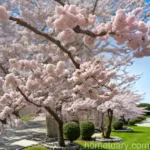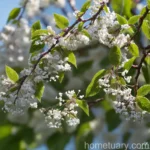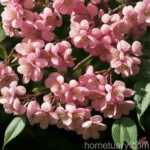Chokecherry (Prunus virginiana): A Comprehensive Guide
Plants play a crucial role in our ecosystem, providing sustenance and beauty to the world around us. Among the vast array of plant species, the chokecherry (Prunus virginiana) stands out for its ecological importance, cultural significance, and numerous practical uses. In this comprehensive guide, we will delve into the world of chokecherries, exploring their cultural, ecological, and botanical aspects. We will cover their cultivation, benefits, uses, and much more.
What is Chokecherry (Prunus Virginiana)?
Chokecherry (Prunus virginiana), also known as bitter-berry, Virginia bird cherry, and western chokecherry, is a deciduous shrub or small tree belonging to the Rosaceae family. It is native to North America and is widely distributed across the continent, thriving in diverse habitats ranging from moist woodlands to dry prairies. The chokecherry plant is characterized by its distinctive clusters of fragrant white flowers and dark red to purple, astringent fruits, which are edible when properly processed.
Key Takeaways
Before we dive deeper into the various aspects of chokecherry cultivation and usage, let’s explore some key takeaways about this remarkable plant. The following are the essential points we will be discussing in this guide:
- Culture: Understanding the cultural significance and folklore associated with chokecherries.
- Uses: Exploring the traditional, culinary, and medicinal uses of chokecherries.
- Water: Discussing the water requirements for growing healthy chokecherry plants.
- Sunlight: Analyzing the optimal sunlight conditions for chokecherries to thrive.
- Fertilizer: Identifying the appropriate fertilization practices for chokecherry cultivation.
- Soil: Understanding the ideal soil conditions for planting and growing chokecherries.
- Pruning: Learning about the pruning techniques to maintain and shape chokecherry plants.
- Propagation: Exploring the various methods of propagating chokecherries.
- Container Cultivation: Discussing the possibility of growing chokecherries in containers.
- Popularity: Examining the rising popularity of chokecherries in various applications.
- Diseases and Pests: Addressing common diseases and pests that affect chokecherry plants.
- Botanist’s Tips: Insights and tips from botanists for successful chokecherry cultivation.
- Fun Facts: Uncovering intriguing and lesser-known facts about chokecherry plants.
Now, let’s embark on a journey to unravel the fascination and practicality of chokecherry (Prunus virginiana) cultivation and usage.
Culture
Folklore and Mythology
Chokecherries have long been a part of various cultural traditions and folklore, particularly among Native American communities. The plant holds symbolic and practical significance in indigenous folklore, where it is often associated with themes of resilience, rebirth, and healing. Several Native American tribes have utilized different parts of the chokecherry plant for various purposes, including medicinal treatments, spiritual ceremonies, and traditional crafts. Folklore and mythology surrounding the chokecherry plant continue to be an integral part of the cultural heritage of many indigenous communities.
Native American Uses
The indigenous peoples of North America have a deep-rooted history of utilizing chokecherries for food and medicine. The fruits were traditionally harvested and processed to make pemmican, jams, and beverages. The bark and leaves of the plant were also used to create natural dyes for textiles, showcasing the versatile nature of the chokecherry in traditional Native American practices. Additionally, the plant’s wood was employed in crafting tools and ceremonial items, further emphasizing its cultural significance.
Uses
Culinary Applications
Chokecherries have a diverse range of culinary applications, with their tart flavor adding a unique dimension to various dishes and beverages. The fruits can be used to create jams, jellies, and syrups, offering a delightful blend of sweetness, acidity, and vibrant color. Chokecherries are also used in the preparation of savory sauces, dessert recipes, and beverages such as wine, tea, and smoothies, showcasing their versatility in the kitchen.
Medicinal Properties
Rich in antioxidants and phytochemicals, chokecherries possess potential health benefits. Traditionally, various parts of the plant, including the fruits, bark, and leaves, have been used in herbal remedies to address ailments such as colds, stomach discomfort, and inflammation. Additionally, the high antioxidant content of chokecherries contributes to their purported immune-boosting properties, making them a valuable natural resource for promoting overall well-being.
Water
Proper moisture management is essential for the health and vitality of chokecherry plants. While chokecherries exhibit good drought tolerance once established, adequate watering is crucial during their initial establishment phase and in prolonged dry spells. Providing consistent moisture, especially during the flowering and fruiting stages, promotes optimal fruit development and overall plant vigor. However, it is important to avoid waterlogged conditions, as excessive moisture can lead to root rot and other complications.
Sunlight
Chokecherries thrive in full sun to partial shade, making them adaptable to a range of light conditions. When grown in full sun, the plants typically exhibit vigorous growth, abundant flowering, and prolific fruit production. However, they can also tolerate partial shade, especially in regions with intense summer heat, where some protection from the midday sun can be beneficial. Overall, providing sufficient sunlight is crucial for maximizing the plant’s fruiting potential and overall vitality.
Fertilizer
Feeding chokecherries with a balanced fertilizer can support their growth and fruiting capabilities. Opt for a slow-release, organic fertilizer that provides essential nutrients without promoting excessive vegetative growth. Apply the fertilizer in early spring as new growth emerges, following the recommended application rates based on the plant’s age and size. Over-fertilization should be avoided, as it may lead to an imbalance of nutrients and potentially hinder fruit production.
Soil
A well-draining, loamy soil with a slightly acidic to neutral pH range is ideal for cultivating chokecherries. The plants prefer soil that is rich in organic matter and capable of retaining moisture without becoming waterlogged. Prior to planting, it is beneficial to amend the soil with organic compost to enhance its structure and fertility. Avoid heavy clay soils and extremely sandy soils, as they can impede root development and overall plant health.
Pruning
Regular pruning is essential for maintaining the shape, health, and productivity of chokecherry plants. Prune the plants during the dormant season, typically in late winter or early spring, to remove dead or diseased wood, promote air circulation, and stimulate new growth. Additionally, selective pruning can help manage the plant’s size and shape, preventing it from becoming overly dense or unruly. When pruning chokecherries, always utilize clean, sharp tools to make precise cuts and minimize stress on the plant.
Propagation
Chokecherries can be propagated through various methods, including seed propagation, hardwood cuttings, and suckering. Each method offers distinct advantages and considerations, allowing growers to choose the most suitable approach based on their specific needs and resources. Seed propagation is ideal for producing new chokecherry plants from collected seeds, while hardwood cuttings offer a reliable method for cloning desirable varieties. Suckering, a natural reproductive strategy of chokecherries, involves harvesting and transplanting emerging shoots from the plant’s root system.
Container Cultivation
While chokecherries are typically grown in traditional garden settings, they can also thrive in large containers or pots. When cultivating chokecherries in containers, select a spacious, well-draining pot and use a high-quality, nutrient-rich potting mix. Ensure that the container has adequate drainage holes to prevent waterlogging, and position it in a location that receives ample sunlight. Regular watering, fertilization, and seasonal root pruning may be necessary to maintain the health and vigor of chokecherry plants in containers.
Popularity
The popularity of chokecherries has been steadily growing, driven by increased interest in native and edible plant species, as well as their diverse culinary and ecological benefits. Numerous culinary enthusiasts, foragers, and conservationists have recognized the value of chokecherries as a versatile and ecologically important plant. This rising popularity has led to the incorporation of chokecherries into various food products, natural remedies, and ecological restoration initiatives, highlighting their relevance in contemporary contexts.
Common Diseases
Chokecherries are susceptible to several common diseases, including powdery mildew, leaf spot, and black knot fungus. Identifying the symptoms and employing proactive management strategies is crucial for mitigating the impact of these diseases and promoting the long-term health of chokecherry plants. By practicing good sanitation, providing proper air circulation, and utilizing disease-resistant cultivars, growers can effectively reduce the risk of disease outbreaks and minimize the need for chemical interventions.
Disease Diagnosis
When observing signs of disease on chokecherry plants, it is important to accurately diagnose the specific pathogen or condition responsible for the symptoms. Conduct a thorough examination of the affected plant parts, taking note of any discoloration, lesions, or abnormal growth patterns. Consult reputable gardening resources, local extension services, or professional plant diagnosticians to aid in the accurate identification of the disease and the development of targeted management strategies.
Common Pests
Chokecherries are vulnerable to attacks from various insect pests, including aphids, caterpillars, and borers, which can detrimentally impact the plant’s growth and fruit production. Regular monitoring of chokecherry plants for signs of pest activity is essential for early intervention and effective pest control. Employing cultural practices, natural predators, and targeted insecticidal treatments can help manage pest populations while minimizing the ecological impact on beneficial organisms and pollinators.
Botanist’s Tips
Successfully cultivating and caring for chokecherry plants requires attention to detail and an understanding of their specific needs. Here are some valuable tips from botanists and horticultural experts to ensure the optimal growth and performance of chokecherries:
- Cultivate Native Varieties: Consider utilizing native chokecherry varieties that are adapted to the local climate and environmental conditions, promoting ecological sustainability and resilience.
- Promote Biodiversity: Integrate chokecherries into diverse ecosystems and habitat restoration projects to support wildlife and enhance ecological balance.
- Encourage Symbiotic Relationships: Foster beneficial interactions by incorporating plants that complement and support the growth of chokecherries, such as nitrogen-fixing legumes or pollinator-friendly flowers.
- Monitor Soil Moisture: Regularly assess soil moisture levels to ensure a balanced and consistent watering regimen, adjusting irrigation practices based on seasonal variations and plant growth stages.
- Prune Mindfully: Practice thoughtful and selective pruning to maintain the natural form of chokecherry plants while removing damaged or excessive growth to promote overall plant health.
- Engage in Sustainable Harvesting: If foraging chokecherries from the wild or cultivating them for personal use, do so responsibly by adhering to ethical harvesting practices and conservation principles.
Fun Facts
Delve into some fascinating and lesser-known facts about chokecherries that highlight their unique characteristics and contributions to the natural world:
- Ecological Importance: Chokecherries are valuable wildlife plants, serving as a food source for numerous bird species, including robins, grosbeaks, and waxwings.
- Native Range: The native range of chokecherries extends from the northern regions of Canada to the mountains of Mexico, showcasing their adaptability in diverse ecosystems.
- Ornamental Appeal: In addition to their practical uses, chokecherry trees are appreciated for their ornamental value, with their spring blooms and vibrant fall foliage adding beauty to landscapes.
- Historical Significance: Chokecherries have a rich history of being utilized by indigenous communities for sustenance, medicine, and ceremonial purposes, reflecting their enduring cultural significance.
- Wildcrafting Potential: Wildcrafters and foragers value chokecherries for their abundance in the wild and the diverse products that can be created from their fruits, leaves, and bark.
Links to External Resources
Chokecherry (Prunus virginiana) Resources
- USDA Plants Database – Prunus virginiana
- North Dakota State University Extension – Chokecherries
- University of Minnesota Extension – Chokecherry Selection and Landscaping
- Alberta Agriculture and Forestry – Chokecherry Pruning
In conclusion, chokecherry (Prunus virginiana) stands as a multifaceted plant with a rich cultural history, ecological significance, and practical utility. Through a nuanced understanding of its cultivation, uses, and ecological role, we can appreciate the invaluable contributions of this native plant species. Whether in traditional recipes, wildlife habitats, or ecological restoration efforts, chokecherries continue to be cherished for their diverse benefits and enduring legacy.
By exploring the diverse dimensions of chokecherries, we gain insights into the intricate relationship between plants and people, as well as the broader ecological tapestry to which they belong. As we delve into the realm of chokecherries, let us embrace their cultural, culinary, and ecological allure, honoring their place in our natural world.















